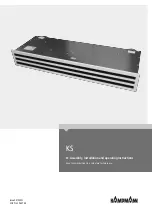
5169032-UIM-C-0416
4
Johnson Controls Unitary Products
SECTION III: UNIT INSTALLATION
UNIT SIZING
1.
The size of the unit should be based on an acceptable heat loss or
gain calculation for the structure. The ACCA – Manual J or other
approved methods may be used. Reference Figure 3 and Table 1.
2.
Only connect the air handler to a duct system which has an external
static pressure within the allowable range.
3. Airflow must be within the minimum and maximum limits approved
for electric heat, indoor coils and outdoor units.
4.
When an air handler is installed so that supply ducts carry air circu-
lated by the air handler to areas outside the space containing the
air handler, the return air shall also be handled by duct(s) sealed to
the air handler casing and terminating in the space to be cooled/
heated.
5.
Refer to the unit rating plate for the air handler model number, and
then see the dimensions page of this instruction for supply air ple-
num dimensions. The plenum must be installed according to the
instructions.
6.
The installer must check available supply power and verify that it is
within the normal operating voltage range for the unit. The accept-
able voltage range for these units is as follows:
CLEARANCES
Clearances must be taken into consideration, and provided for as
follows:
1.
Refrigerant piping and connections - minimum 12” recommended.
2.
Maintenance and servicing access - minimum 36” from front of unit
recommended for blower motor / coil replacement.
3.
Condensate drain lines routed to clear filter and panel access.
4.
Filter removal - minimum 36” recommended.
5.
The duct work connected to this unit is designed for zero clearance
to combustible materials.
6. A combustible floor base accessory is available for downflow appli-
cations of this unit, if required by local code.
LOCATION
Location is usually predetermined. Check with owner’s or dealer’s
installation plans. If location has not been decided, consider the
following in choosing a suitable location:
1.
Select a location with adequate structural support, space for service
access, and clearance for air return and supply duct connections.
2.
Using hanging brackets to wall mount this single piece air handler
unit is not recommended.
3.
Normal operating sound levels may be objectionable if the air han-
dler is placed directly over some rooms such as bedrooms, study,
etc.
4.
Select a location that will permit installation of condensate line to an
open drain or outdoors allowing condensate to drain away from
structure.
5.
When an indoor coil is installed in an attic or above a finished ceil-
ing, an auxiliary drain pan should be provided under the air handler
as is specified by most local building codes.
6.
Proper electrical supply must be available.
7.
If unit is located in an area of high humidity (i.e. an unconditioned
garage or attic), nuisance sweating of casing may occur. On these
installations, unit duct connections and other openings should be
properly sealed, and a wrap of 2” fiberglass insulation with vinyl
vapor barrier should be used.
AIR HANDLER CONFIGURATION
These air handler units are supplied ready to be installed in an upflow
or horizontal left position. Refer to Figure 4. If the unit requires either
downflow or horizontal right airflow configurations, the unit must have
the coil assembly repositioned. Refer the Downflow or Horizontal Right
Conversion procedures.
DOWNFLOW OR HORIZONTAL RIGHT CONVERSION
1.
Remove coil access panel.
2.
Slide coil/drain pan assembly out of air handler.
3.
Note the lettered position of the center support bar for the coil/drain
pan. Remove the center support bar by sliding the forward end of
the support bar to the right or left until the lower finger clears the
structure.
NOTICE
Avoid handling aluminum coil components after handling the copper
line set or other tubing without first cleaning hands.
Entering Air Temperature Limits
Wet Bulb Temp.°F
Dry Bulb Temp. °F
Min.
Max.
Min.
Max.
57
72
65
95
Air Handler Voltage
Normal Operating
1
Voltage Range
1. Rated in accordance with ARI Standard 110, utilization range “A”.
208V-230V-1-60
187V-253V
NOTICE
The primary and secondary drain line must be trapped to allow proper
drainage of condensate water. The secondary drain line should be
piped to a location that will give the occupant a visual warning that the
primary drain is clogged. If the secondary drain line is not used, it
must be capped.
FIGURE 4:
Typical Installation
NOTICE
Convert air handler to correct orientation prior to installation. Conver-
sion must be made before brazing the refrigerant connections to the
coil.
NOTICE
The center support bar for the coil/drain pan has a position identifier
embossed into the cabinet structure between the two forward fingers
of the support bar. There are four position identifiers: A, B, C, or D.
The lettered hole location can differ from unit to unit due to the cabi-
net width of the air handler. After removal and reinstallation, the cen-
ter support bar must be installed in the same lettered position that it
was originally.
UPFL
O
W
H
O
RIZ
O
NTAL RIGHT
H
O
RIZ
O
NTAL LEFT
HEAT
HEA
T
HEA
T
D
O
WNFL
O
W
HEAT
A
0
33
0
-
001





























